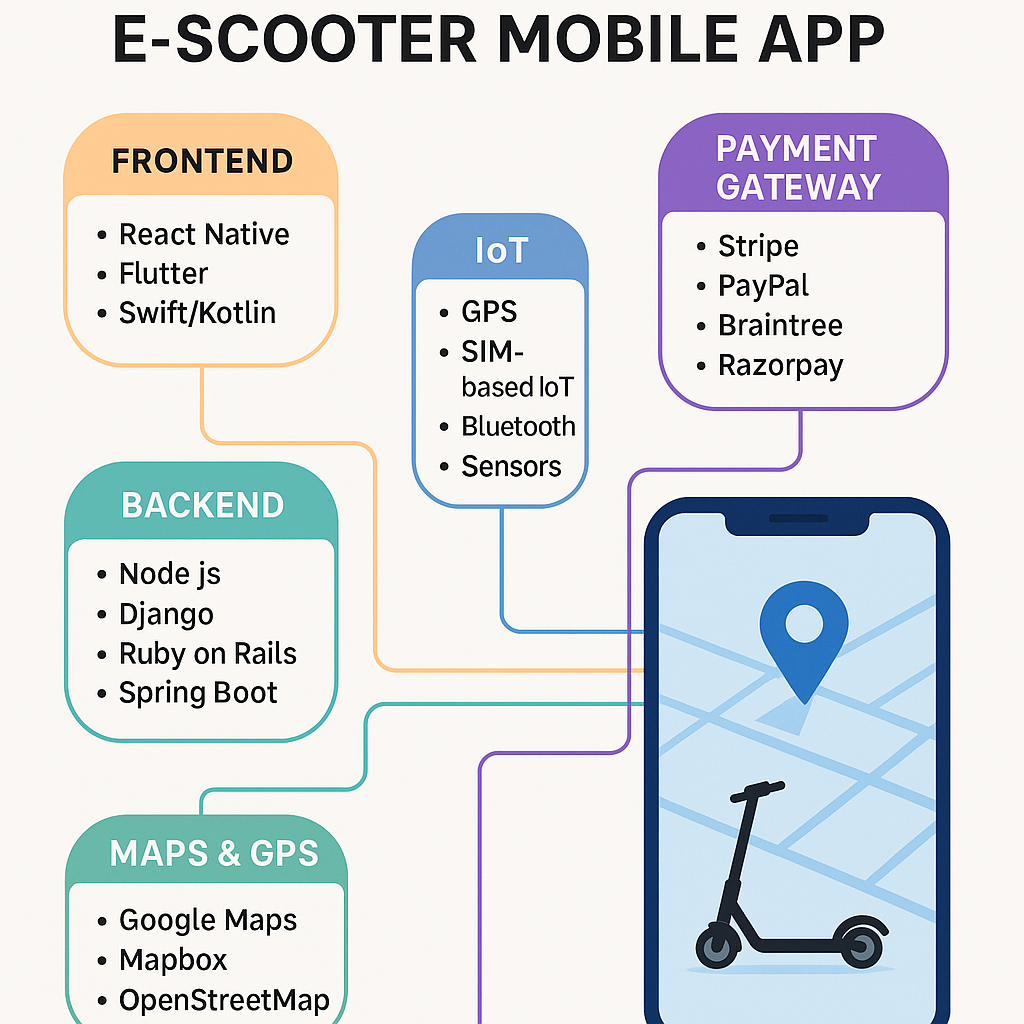The rise of micro-mobility has transformed how people move within cities, and e-scooter apps have become a key part of this revolution. With the growing demand for eco-friendly and convenient urban transportation, building an e-scooter mobile app is a highly lucrative business opportunity. However, the success of such an app depends greatly on choosing the right technology stack. This blog explores the essential tech stack for a successful e-scooter mobile app and the important considerations during e scooter App Development.
Understanding the Core Requirements of an E-Scooter Mobile App
Before selecting the technology stack, it is essential to understand what an e-scooter app needs to achieve. A successful app should enable users to locate nearby scooters, unlock and ride them, make seamless payments, and end rides efficiently. From the admin perspective, the system must manage vehicle data, monitor battery status, handle maintenance, and generate analytical reports.
Key features typically include:
- Real-time GPS tracking
- QR code scanning for unlocking
- Payment gateway integration
- Push notifications
- Ride history and analytics
- User authentication and profile management
- Fleet and maintenance management
These features require a combination of robust frontend, backend, and IoT technologies to ensure smooth operation and scalability.
Frontend Technologies for a Smooth User Experience
The frontend is the interface users interact with, and it must provide a seamless experience across platforms. Since most users access e-scooter services through smartphones, mobile app development is crucial.
Recommended frontend technologies:
- React Native: A popular framework by Meta for building cross-platform apps with a single codebase. It offers a native-like experience on both Android and iOS.
- Flutter: Developed by Google, Flutter enables the creation of fast and visually appealing apps. It supports smooth animations and works well for real-time features like maps and tracking.
- Swift (for iOS) and Kotlin (for Android): These are ideal for businesses that prefer developing native apps to take advantage of platform-specific performance and optimization.
Important considerations for the frontend:
- Focus on responsive UI and smooth map integrations.
- Optimize app loading speed.
- Ensure easy navigation and accessibility.
Selecting the right frontend technology during e scooter App Development ensures that users enjoy a stable and engaging experience.
Backend Technologies to Handle Core Operations
The backend is the heart of any e-scooter application. It manages data flow between the app, database, and connected scooters. Choosing a reliable backend framework ensures the app can handle multiple requests simultaneously without performance issues.
Top backend frameworks and technologies:
- Node.js: Ideal for real-time applications due to its event-driven architecture and scalability.
- Python with Django or Flask: Offers clean code structure and quick development, perfect for startups.
- Ruby on Rails: Efficient for rapid prototyping and easy integration with APIs.
- Java with Spring Boot: A robust and secure option for enterprise-grade applications.
Additional backend essentials:
- RESTful or GraphQL APIs for smooth communication between app layers.
- Real-time data processing for location updates and vehicle status.
- Cloud-based hosting using AWS, Google Cloud, or Microsoft Azure for scalability and reliability.
A well-structured backend supports thousands of concurrent users and ensures uninterrupted performance.
Database Selection for Real-Time and Scalable Data Storage
An e-scooter app continuously generates large volumes of data such as ride history, GPS coordinates, payment records, and user details. Hence, choosing the right database system is critical.
Best database options:
- PostgreSQL or MySQL: Suitable for structured data like user profiles, transactions, and ride history.
- MongoDB: A NoSQL database perfect for handling unstructured data and providing flexibility in schema design.
- Redis: Often used for caching to enhance performance and reduce response time.
- Firebase Realtime Database: Useful for real-time synchronization, especially for map updates and ride tracking.
Points to remember:
- Ensure the database supports quick read and write operations.
- Optimize indexing and query performance.
- Plan for horizontal scaling to handle increased user activity.
IoT Integration for Smart Connectivity and Fleet Management
IoT (Internet of Things) plays a crucial role in e-scooter apps, connecting physical scooters to digital systems. Each scooter is equipped with IoT modules such as GPS trackers, Bluetooth, and sensors that transmit data to the backend.
Key components of IoT integration:
- GPS Modules: Enable real-time tracking of scooter location.
- SIM-based IoT Devices: Facilitate data transmission via mobile networks.
- Bluetooth Connectivity: Helps in scooter unlocking using the app.
- Sensors: Monitor speed, battery status, and scooter condition.
IoT protocols and platforms:
- MQTT and CoAP: Lightweight protocols for efficient communication between devices.
- AWS IoT Core or Google Cloud IoT: Platforms that handle device management, data routing, and analytics.
Proper IoT integration ensures smooth fleet management, accurate location updates, and better maintenance planning.
Payment Gateway Integration for Seamless Transactions
A smooth and secure payment process enhances user trust and satisfaction. E-scooter apps usually include pay-per-ride or subscription-based models. Integrating reliable payment gateways ensures users can pay conveniently using different methods.
Commonly used payment gateways:
- Stripe
- PayPal
- Braintree
- Razorpay
- Apple Pay and Google Pay
Key considerations for payment integration:
- Support multiple currencies and payment methods.
- Ensure PCI DSS compliance for security.
- Enable features like refunds and wallet management.
When planning your e scooter app development cost, factor in payment gateway fees and maintenance expenses as they are recurring costs associated with financial transactions.
Map and Navigation Integration for Real-Time Tracking
Mapping and navigation form the backbone of e-scooter apps. Users depend on maps to find nearby scooters and track routes during rides. The app should provide real-time updates, accurate distance measurement, and estimated time of arrival.
Top map integration options:
- Google Maps API: Offers reliable navigation, distance calculation, and real-time traffic data.
- Mapbox: Customizable and suitable for large-scale fleet tracking.
- OpenStreetMap: Open-source alternative for startups looking for cost-effective solutions.
Essential map-related features:
- Display of available scooters.
- Real-time route tracking.
- Geo-fencing to restrict rides within specific areas.
- Distance and cost estimation.
Efficient map integration ensures operational transparency and improves user satisfaction.
Cloud and DevOps Solutions for Performance and Scalability
For an e-scooter app to operate efficiently, cloud infrastructure and DevOps practices are essential. They help in continuous deployment, scaling resources, and ensuring uptime even under heavy usage.
Cloud service providers:
- Amazon Web Services (AWS) – Offers Elastic Compute Cloud (EC2), IoT Core, and AWS Lambda for serverless operations.
- Google Cloud Platform (GCP) – Provides tools for analytics, IoT, and real-time data management.
- Microsoft Azure – Known for enterprise-level security and scalability.
DevOps tools and practices:
- Docker and Kubernetes for containerization and orchestration.
- Jenkins or GitHub Actions for continuous integration and deployment.
- Monitoring tools such as Prometheus and Grafana for real-time performance insights.
A reliable cloud and DevOps strategy ensures high availability, reduced downtime, and efficient resource utilization.
Security and Compliance to Protect Data and Users
Security is critical in e-scooter applications, as they handle sensitive user data and payment information. The tech stack must include robust security measures to prevent unauthorized access and data breaches.
Important security practices:
- Use end-to-end encryption for data transmission.
- Implement OAuth 2.0 and JWT for secure user authentication.
- Conduct regular security audits and vulnerability testing.
- Comply with data protection laws like GDPR or CCPA, depending on the operational region.
- Use SSL certificates to secure all communications.
Strong security measures not only protect users but also build trust and credibility in your brand.
Analytics and Reporting Tools for Business Insights
To make data-driven decisions, integrating analytics tools into the e-scooter app is essential. Analytics help track performance, understand user behavior, and optimize fleet usage.
Recommended analytics tools:
- Google Analytics for user activity tracking.
- Mixpanel for event-based analysis.
- Firebase Analytics for in-app performance monitoring.
- Power BI or Tableau for advanced business intelligence and data visualization.
Useful analytics metrics:
- Total rides and active users.
- Average ride duration and distance.
- Scooter utilization rate.
- Revenue and operational cost analysis.
These insights help optimize pricing models, improve service quality, and enhance user engagement.
Integration with Ride Sharing Ecosystems
With the rise of mobility-as-a-service, integrating e-scooter platforms with broader ride sharing systems can increase visibility and user convenience. This integration allows users to access multiple transport modes within a single app, improving overall mobility solutions.
If your business is exploring ride sharing app development, leveraging APIs and open mobility standards like MDS (Mobility Data Specification) and GBFS (General Bikeshare Feed Specification) ensures compatibility and interoperability.
Such integrations enhance customer reach and help businesses operate in a unified urban mobility ecosystem.
Conclusion
Building a successful e-scooter mobile app requires careful selection of the right technology stack. Each layer, from frontend frameworks to backend systems, IoT connectivity, and cloud infrastructure, contributes to the overall reliability and user experience of the app. By combining strong technologies with strategic development practices, businesses can create scalable, secure, and efficient solutions that meet the growing demand for sustainable urban mobility. With the right planning and execution, your e-scooter platform can become a leading player in the micro-mobility industry.


